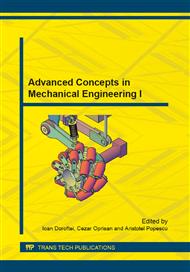p.389
p.395
p.401
p.407
p.413
p.417
p.423
p.429
p.435
Evaluation of Comfort Degree for Pushing/Pulling Motions under the Influence of Controlled Induced Vibrations in the Fingers-Hand–Arm Assembly
Abstract:
Handling different objects, by pulling/pushing motions is influenced by the environment both by its meteorological parameters (temperature, humidity, pressure) and by the operating parameters of the used equipments and devices (vibrations/shocks, noises, intermittent light sources etc.). These influences are materialized by changes in the worker’s comfort degree, by accomplishing the processing accuracy or information acquisition by the human factor. In the first part of the paper some general aspects concerning the influence of vibrations upon the human body are presented, especially for the fingers, hand-arm assembly. In the second part, the methodology and experimental system used for the evaluation of the comfort degree of pulling/pushing motions under the influence of some controlled induced categories of vibrations are described. Following this methodology, the physiological and anatomical limits of motion for each part of the assembly (fingers, hand and arm) are studied, during the pulling/pushing motions and are respectively subjected to a set of controlled induced vibrations. Also these measurements are correlated by computerized methods with the stability degree and posture of the human body. In the final part of the paper we analyze the results and determine the comfort degree for a target group of 10 subjects without malfunctions of the handling system or of the locomotion system.
Info:
Periodical:
Pages:
413-416
Citation:
Online since:
October 2014
Authors:
Price:
Сopyright:
© 2014 Trans Tech Publications Ltd. All Rights Reserved
Share:
Citation:


